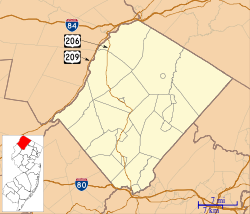Sterling Hill Mine
|
Sterling Hill Mine Tour & Museum
|
|
 |
|
| Location | 30 Plant Street, Ogdensburg, New Jersey |
|---|---|
| Coordinates | 41°4′59″N 74°36′24″W / 41.08306°N 74.60667°WCoordinates: 41°4′59″N 74°36′24″W / 41.08306°N 74.60667°W |
| Architectural style | Industrial |
| NRHP Reference # | 91001365 |
| Significant dates | |
| Added to NRHP | September 3, 1991 |
| Designated NJRHP | July 11, 1991 |
The Sterling Hill Mine, now known as the Sterling Hill Mine Tour & Museum of Fluorescence, is a former iron and zinc mine in Ogdensburg, Sussex County, New Jersey, United States. It was the last working underground mine in New Jersey when it closed in 1986. It became a museum in 1989. Along with the nearby Franklin Mine, it is known for its variety of minerals, especially the fluorescent varieties. It was added to the National Register of Historic Places on 1991.
Mining began at the site in the 1630s, when it was mistakenly thought to be a copper deposit.George III of the United Kingdom granted the property to William Alexander, titled Lord Stirling. Stirling sold it to Robert Ogden in 1765. It went through several owners until the various mines were combined into the New Jersey Zinc Company in 1897. The mine closed in 1986 due to a tax dispute with the town, which foreclosed for back taxes in 1989 and auctioned the property to Richard and Robert Hauck for $750,000. It opened as a museum in August 1990.
The ore bodies at the Sterling Hill mine lie within a formation called the Reading Prong massif; the ores are contained within the Franklin Marble. This was deposited as limestone in a Precambrian oceanic rift trough. It subsequently underwent extensive metamorphosis during the Grenville orogeny, approximately 1.15 billion years ago. Uplift and erosion during the late Mesozoic and the Tertiary exposed the ore bodies at the surface; the glaciers of the strewed trains of ore-bearing boulders for miles to the south, in places creating deposits large enough to be worked profitably.
...
Wikipedia



